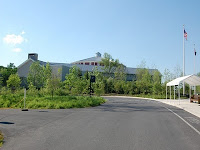We revisit the C & O Canal National Historical Park in Williamsport, Maryland.
Picture from 2011 post. You can
see the missing wall on the side
of the aqueduct. Click on the
picture to see a larger version.
After a ten-year stint on the west coast we’ve returned to the
mid-Atlantic and the first thing we did was visit some of our old haunts and
favorite historical sites. One of the first places we went to was the C & O
Canal National Historical Park site in Williamsport, Maryland. I did a post on the canal towpath and the park back in 2011, as well as a post about the Paw Paw Tunnel, located up the canal about thirty miles. Give that first post a read
to find out the history of the Chesapeake & Ohio Canal and what it is today.
Here is a pretty good video that will also give you a rundown on the history of the canal.
 |
| An aqueduct is a bridge for water. |
 |
| Now there is water in the aqueduct at Williamsport. |
An aqueduct is built to carry water. In the case of the C
& O, the aqueducts were built to carry boats over existing rivers. When I
visited ten years ago, the aqueduct in Williamsport was missing a wall and
visitors used it like a bridge to cross Conococheague Creek. The old canal had
been filled in so you could walk from the visitors center around the turning
pond and immediately be on the towpath. Now the aqueduct has been restored. The
canal was dug out so that it connects to the turning pond, fills the aqueduct,
and runs maybe forty yards beyond the north end of the aqueduct. This is a
great improvement. My wife shared with me that before the improvement, she
couldn’t visualize what the aqueduct did, since it looked like, and was used
as, a bridge. Now that it has been repaired and has water in it, its function
is clear.
 |
| That small portion of the canal connects to the turning pond. |
 |
| Less than a half mile walk down the towpath is Lock #44. |
 |
| A walkway on the elevated railroad bridge allows access to the towpath. |
 |
| There is a new park headquarters up the hill, but the Visitors Center is still in the barn by the pond. |
 |
| The towpath trail is pet friendly. Elvis the Corgi approves. Please stay leashed and pick up. ;-) |



























